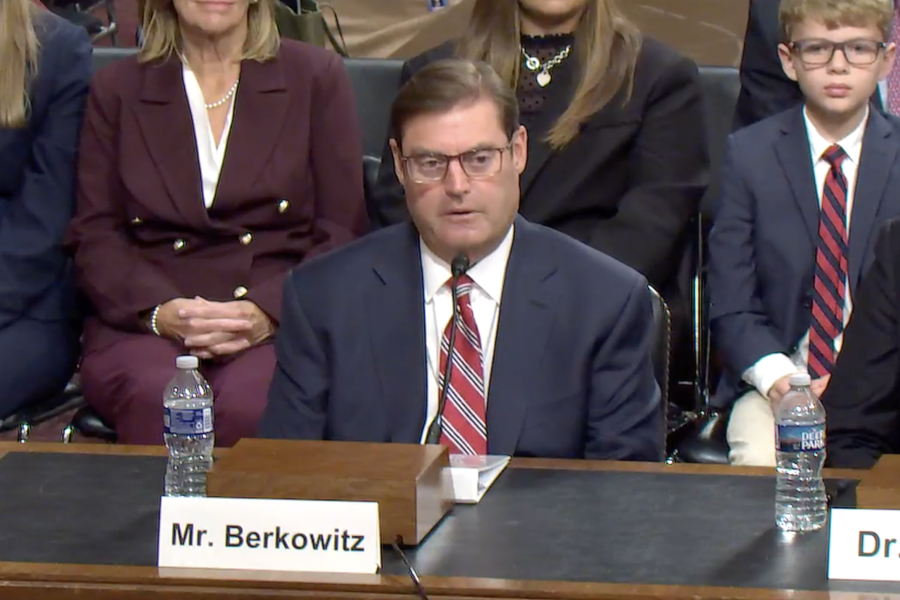Marc Berkowitz, the Trump administration’s nominee to serve as assistant secretary of defense for space policy, told lawmakers he would consider “all options” for improving the efficiency of the national security space enterprise, including combining some functions of the Space Force and the National Reconnaissance Office.
A former assistant deputy undersecretary of defense for space policy, Berkowitz has written on the topic on several occasions. In an essay published this July, Berkowitz argued for a closer relationship between the two organizations, particularly for acquisition functions.
The essay, co-written with former DOD official Chris Williams, discussed the potential merits of merging the NRO and the Space Force’s primary acquisition hub, Space Systems Command. It also considered options to expand technical collaboration between DOD and the Intelligence Community and better integrate force design activities between the NRO and the Space Warfighting Analysis Center.
In a separate editorial published in Space News in February, Berkowitz said “consideration should be given” to better aligning Space Force and NRO acquisition authority and funding. Further, he pointed to the potential cost savings that could come from merging NRO and SSC and closing Los Angeles Space Force Base in California, which hosts the acquisition field command.
In response to several questions during his Oct. 28 confirmation hearing before the Senate Armed Services Committee, Berkowitz said the essays were “intentionally thought-provoking,” but that he wasn’t advocating for a particular approach.
“I frankly just believe that we should be open to all options to improve the efficiency and effectiveness of national security space capabilities,” Berkowitz told lawmakers.
Berkowitz also noted in his answer to a question from the committee’s ranking member, Sen. Jack Reed (D-R.I.) that for decades the NRO director’s role was dual-hatted, with that official also serving as Air Force Undersecretary or in another senior position. Indeed, that was the practice from the formation of the NRO in 1961 until the early 2000s, when then-Defense Secretary Donald Rumsfeld split the role into two distinct positions.
At the time, Pentagon leaders said the move was necessary to ensure both roles received the dedication they deserved. Berkowitz, however, said the dual-hatted approach was largely successful.
“Throughout much of the history of the national security space program, either the secretary, undersecretary, or assistant secretary for space in the Department of the Air Force was dual-hatted as the director of the NRO,” Berkowitz said during the hearing. “For much of that time, both the defense and National Reconnaissance programs were run very efficiently and effectively, and so if that is an option that’s worth considering, I would support it if it was appropriate.”
In written responses to the committee’s advance policy questions, Berkowitz acknowledged that any major change from current policy could be disruptive and noted that the department should “first do no harm and weigh the consequences” of either maintaining the status quo or moving ahead with consolidation or other reforms.
Senators also raised questions about Berkowitz’s space policy priorities and his perspective on threats posed by U.S. adversaries like China and Russia. Berkowitz said his first objective, if confirmed, would be to ensure DOD has the capabilities it needs to maintain dominance in the domain and protect against aggression.
“The challenges that I would expect to confront, if confirmed, are really twofold,” he said. “The first is addressing the national security policy issues required to enable us to deal effectively and urgently with the pace, scope, and complexity of space and missile threats. And the second is the broader national policy issues to sustain the United States’ position as the world’s leader in space exploration and use.”
Berkowitz pointed to the Pentagon’s Golden Dome missile defense effort as an important element of that architecture, noting that the command-and-control elements of that advanced missile defense network are key enablers for capabilities like ground- and space-based interceptors.
“The fusion capabilities and the sense-making capabilities are going to be essential for ensuring that we actually can engage and defeat any threats,” he said.


